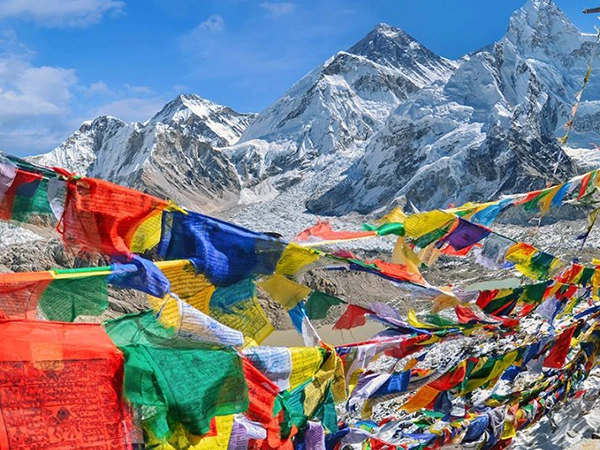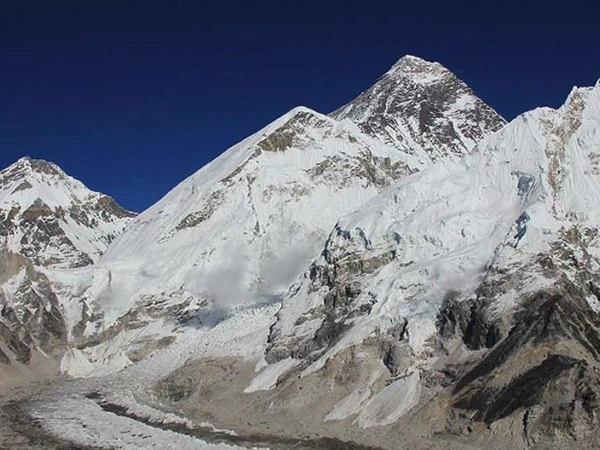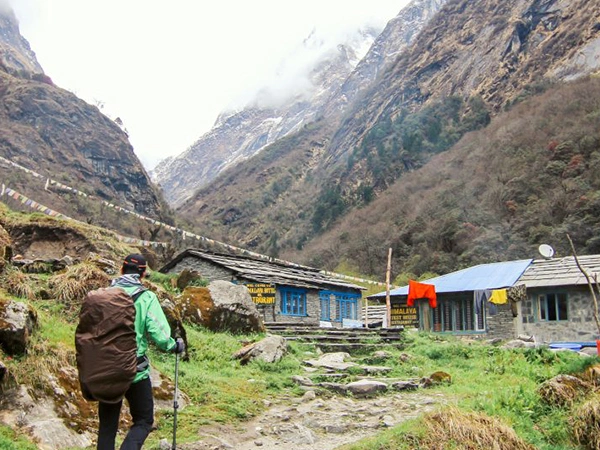Annapurna Base Camp is the most captivating trekking destination in Nepal. The trek is renowned for offering exceptional views of Himalayan landscapes. This exciting adventure presents unforgettable experiences. The trek takes you to diverse landscapes of the Annapurna Region and rewards you with rich cultural experiences. For a delightful journey to this pristine region, it is essential to select the right time.
The best time for Annapurna Base Camp Trek is Spring (March to May) and Autumn (September and November). During these two peak seasons the weather is dry and stable with moderate temperatures, which is considered ideal for trekking. In addition, the clear skies and great visibility at these periods allow for a more comfortable and secure trek. You will get rewarded with crystal clear vistas of mountains such as Annapurna I, Hiunchuli, Machapuchhre and many others during this period.
Trekkers favor spring and autumn as these seasons present alluring mountain vistas and favorable trail conditions, which makes the Himalayan journey more convenient. In addition, this season ensures a smooth journey in varied terrains of Annapurna Region allowing trekkers to explore when the beauty of nature is at its peak. Thus, the clearer skies, weather stability and moderate temperatures make Autumn and Spring stand out as best time to do the Annapurna Base Camp Trek
Understanding Annapurna’s Trekking Seasons: Best Time To Trek Annapurna Base Camp
Spring (March to May): Blossoms and Clear Views
Spring is the ideal time to visit Annapurna Base Camp area because of favorable weather conditions and awe inspiring sceneries. During spring season, skies are vivid with fewer clouds making it the perfect time to undertake trekking and exploring the pristine Annapurna Base Camp.
This season’s upgraded visibility and stable temperatures reward trekkers with exceptional views of iconic peaks like Annapurna I, Nilgiri, Machhapuchhre and many others. The trails are particularly beautiful during this time as rhododendrons and many other Himalayan wildflowers paint the landscape with colorful shades.
The forests of the hillsides decorated with blooming flora, lush valleys, and snowy mountains in the background make the journey visually stunning and immersive, offering you numerous opportunities to capture beautiful snapshots.
Annapurna Base Camp Weather Conditions During Spring
During the spring months, the daytime temperatures are generally moderate, making your exploration convenient and smooth. The evenings and late nights are mostly chilly and cool. However, by layering up you can stay warm and cozy.
The temperature is mild during these periods, and you can enjoy the refreshing spring ambiance without facing the extreme cold conditions. Besides, dry trails of spring enhance safety. The weather is stable around this period with minimal possibilities of heavy downpours or snow showers.
This reduces risk of slippery paths or landslides and makes traversing challenging parts of the trek more convenient. Spring is the most suitable time for the trek as it offers perfect combination of weather, visibility and beautiful landscape colors allowing trekkers to enjoy sceneries offered by Annapurna Base Camp Trek at its best.
Temperature of Annapurna Base Camp During Spring Months
| Months | Maximum Temperature | Minimum Temperature |
| March | 5°C | – 8 °C |
| April | 7 °C | – 4°C |
| May | 15 °C | 0°C |
Tips for Annapurna Base Camp Trekking in Spring
- Book the trek package early. Spring is a popular trekking season.So, to secure the best accommodations and best-deal trekking packages, it is highly recommended that you trek in the spring season.
- While the daytime weather is moderate, the mornings and nights can still be colder in the Himalayas. Thus, you must dress in layers to prepare for changing conditions.
- Ensure proper hydration and carry water purification tablets and high energy snacks to stay healthy and gain energy throughout the journey.
- Spring is the season of blooming flora. Take your time to enjoy and appreciate this enchanting gift of nature and take beautiful photographs.
- Carry sun protection items such as (sun creams, sunglasses and sun hat) to protect yourself from sunburn as you will be trekking for long hours under the sunlight.
Autumn (September to November): The Ideal Season
Why is Autumn The Most Popular Time for Annapurna Base Camp Trek?
Autumn is considered best time of year for Annapurna Base Camp Trek due to its exceptional clarity and clear views. This is a post monsoon season and the skies are crisp and cloudless after the monsoon rains. Opting for the Annapurna Base Camp Trek in autumn rewards you with unobstructed views of the Annapurna range and many other peaks.
The air is clear during this season and the landscapes of Annapurna Region look surreal under the deep blue skies. In addition, the crystal clear and panoramic views of the iconic snow-capped Annapurna I, Machapuchare and Dhaulagiri can be seen even from a distance, enhancing the sightseeing journey.
Likewise, walking through the surrounding valleys, terraced fields and small mountain villages in a rejuvenating autumn atmosphere makes the trekking more immersive. The sight of mountains glowing because of the sun’s rays is fascinating. The stunning views of Himalayan landscapes and the serene environment make autumn the most popular and rewarding season for Annapurna Base Camp Trek.
Weather Conditions of Annapurna Base Camp in Autumn Season
The weather during autumn is pleasant and considered perfect for the Annapurna Base Camp Trek. The clear skies offer enchanting views of landscapes and towering peaks. The autumn air is fresh and crisp. The trails are well-defined and ideal for trekking.
The dry terrains of this period make navigation easier and less exhausting. This post-monsoon time rewards trekkers with the most stable weather conditions. Without the chances of rainfall and heavy snow, you can enjoy trekking in the most delightful autumn atmosphere. In addition, the skies are less cloudy and the stable weather reduces the risks of unforeseen circumstances like landslides or storms. This allows you to complete your trek in within your decided timeframe.
The daytime weather is mild and sunny and evenings are cool. As trekkers progress towards higher zones, the temperature may gradually drop but it’s not as extremely cold as the winter season. Likewise, the well-defined trails allow you to traverse smoothly through the varied terrains of the Annapurna Region, which makes your journey easier and more memorable.
Average Temperature of Annapurna Base Camp in Autumn Months
| Months | Maximum Temperature | Minimum Temperature |
| September | 18°C | 0°C |
| October | 10 °C | -5°C |
| November | 8°C | -10 °C |
Tips for Annapura Base Camp Trek in Autumn
- A lot of trekkers visit Annapurna Base Camp Trek in autumn. Thus, it is the busiest season. So, book the trip in advance for a delightful journey. Booking the package early also helps you secure the best accommodation.
- Stay hydrated and ascend gradually to ensure proper acclimatization.
- The weather is generally stable during this season. However, light rain showers in the early days of September is possible. So, pack the rain gear. In addition, while the days are warm and sunny, the temperature can drop at night in higher zones. Thus, bridging warm clothes and sleeping bags are necessary for a comfortable stay.
Winter (December to February): A Snowy Adventure
Unique Experience of Winter Season
Trekking to Annapurna Base Camp in winter offers unique experiences. You can enjoy beautiful views of snow covered terrains and a quiet atmosphere. This mainstream region gets fewer visitors during this period which helps you admire the Himalayan environment in more peaceful setting.
In addition, the Annapurna range peaks are covered with a thick layer of snow, which is fascinating. There are very fewer clouds in skies so you can enjoy the clear views of the lush hills and mountains which is mesmerizing.
Challenges of Annapurna Base Camp Trek in Winter
Trekking to Annapurna Base Camp in winter offers unique experiences. You can enjoy beautiful views of snow covered terrains and a quiet atmosphere. This mainstream region gets fewer visitors during this period which helps you admire the Himalayan environment in more peaceful setting.
In addition, the Annapurna range peaks are covered with a thick layer of snow, which is fascinating. There are few clouds in the skies, so you can enjoy the clear views of the lush hills and mountains which is mesmerizing.
Annapurna Base Camp Weather In Winter
In the winter, the Annapurna Region is very cold especially in the early mornings and nights. In addition, the higher altitude zones receive heavy snowfall. Likewise, at higher altitudes, there are possibilities of strong winds, and visibility can be reduced because of the fog. The views of mountains are spectacular but temperature drops significantly which can make trekking relatively challenging for those who arent accustomed to such weather.
The temperature of Annapurna Base Camp In Winter Season
| Months | Maximum Temperature | Minimum Temperature |
| December | 4 °C | -14°C |
| January | 2°C | -19°C |
| February | 2°C | -20 °C |
Tips for winter Trekking
- Putting on enough layers of warm clothing and bringing high-quality sleeping bags to handle the freezing conditions is essential. The extreme cold can increase the risk of Hypothermia and frostbite. Thus, it is essential to keep yourself warm.
- Always check the current conditions of trails with local guides and head out only after confirming that paths are favorable.
- Make sure to inquire about the availability of accommodation at the higher zones. Confirm the booking in advance.
- Carry the thermos bottle where you can store the hot water.
- Trek while wearing the insulated trekking boots.
- Begin trekking early in the morning to enjoy the winter scenery and make it your destination before the night.
Monsoon/Summer (June to August): Off-Season Adventures
Monsoon/ Summer is considered off-season for trekking. At this time the lower zones can be warm, while higher altitudes are still chilly. As it is not among the peak seasons, the trails won’t be crowded as it is during the popular times. So, the trails are quieter allowing you to admire the beauty of nature in a serene environment. One of the highlights of trekking this season is the lush greenery, rainbows and rain washed landscapes. In addition, the cascading waterfalls and mountain views in the clear mornings after rainfall in the late afternoon are mesmerizing in this season.
Challenges Presented by Monsoon/ Summer Season
The heavy downpours may lead to muddy, wet and slippery trails, making navigation difficult. In addition, the leeches can be traced in forested paths, which can be very unpleasant for the trekkers. A notable concern during this time is the possibility of natural calamities like landslides because of the frequent heavy downpours, which may disrupt your travel schedule. In addition, the cloud covers can reduce the visibility disrupting smooth navigation.
Annapurna Base Camp Weather In Monsoon/ Summer
The weather is generally unpredictable during the Monsoon season. The temperature is warmer at lower altitudes and cooler or chilly at high altitudes and base camp areas. Thus, on clear days, smooth traversing is possible. However, rainfalls are frequent and visibility can be reduced at any time. So, you must be prepared for the changeable weather and cautious while trekking.
Average Temperature of Annapurna Base Camp in Monsoon/ Summer Months
| Months | Maximum Temperature | Minimum Temperature |
| June | 16°C | 3 °C |
| July | 17 °C | 7 °C |
| August | 19 °C | 8 °C |
Tips For Safe Trekking During the Monsoon
- Check regular updates of the weather forecast and trek only on suitable conditions.
- Pack rain gears and moisture-wicking base layers to stay dry and comfortable.
- Pack insect repellents in your daypack.
- Ensure that you are wearing waterproof and high-quality boots while trekking suitable for traversing the muddy trails.
- Drink only boiled and purified water.
Choosing the Best Time For Annapurna Base Camp Trek Based on Your Priorities
Weather
The weather in the spring and autumn seasons is considered the ideal time for Annapurna Base Camp Trek. The weather is clear in this period with mild temperatures and very low chances of rainfall and heavy snow. The daytime temperatures are comfortable and favorable for trekking, but the nights are somewhat chilly at higher altitudes.
In winter, the Annapurna Region is coldest, especially in higher zones. In addition, the trails can be snowy, making navigation relatively difficult. However, this season offers sights of beautiful snow-covered landscapes, and good preparation and adequate packing are required. In summer/ monsoon time, and the trails are muddy and the weather is more unpredictable with risks of unforeseen events. You must be informed about the season’s challenges and prepare accordingly to ensure a smooth journey.
Crowds
During the autumn and spring seasons, the trail is quite crowded. The teahouses are busier and fill up quickly. However, the atmosphere is lively and you can have an interactive journey by communicating with fellow trekkers and friendly locals.
In winter, the trails are tranquil, and fewer trekkers embark on the journey because of the low temperatures and extreme cold at the higher altitudes. So, it can be good for those who wish to trek in solitude. The monsoon season is a less crowded time. So, it can be a good choice for those who want a peaceful trekking experience. However, it is also important to be informed about challenges presented by the off season trek and prepare accordingly.
Best Time Recommendations
The right time also depends on how you want to experience and what you have envisioned seeing during the Annapurna Base Camp trek.
Experienced trekkers and adventurers with excellent fitness may enjoy trekking in the winter season, too, as they are familiar with navigation and well-informed about the weather conditions. However, for beginners, trekking in peak seasons is more manageable. The spring and autumn trekking ensures optimal weather, well-defined trails and excellent visibility which enhances the overall experience. If you love photography, you can choose to trek in the autumn and spring months, as they offer the clearest skies and the most beautiful landscapes.
Preparing for Weather Variability During Annapurna Base Camp Trek
How to Stay Safe during Unpredictable Weather Conditions
Unpredictable weather can be one of major concerns during the Annapurna Base Camp (ABC) trek especially during the transitional periods. Monsoon rains can sometimes be prolonged and make trails slippery and muddy.
In addition, it can also affect visibility. The skies can get covered with clouds obstructing the views. Similarly, unseasonal snowfall during late autumn or early spring is also another concerning factor. The higher altitudes may receive snowfall and cause sudden temperature drops. Thus, it is essential for trekkers to be well equipped with winter gear and warm clothing. This may cause delays in the trek requiring you to add extra days to your itinerary.
Here are some Tips for adapting to Unpredictable Weather Patterns
- Bring Personal First Aid Kit with necessary medicines and Extra Food (High Energy Snacks and Packaged Foods).
- Check weather forecasts regularly. Take information from guides about real time weather forecasts.
- Higher zones are generally on the colder side. So, packing layered clothing (Base layer, Insulating layer and Waterproof Outer Layer) is necessary to quickly adjust to sudden weather changes.
- It is crucial to ensure time flexibility. Sometimes it need adjustments or extra days if there are delays due to bad weather.
Essential packing List for All Seasons
Packing thoughtfully being aware about what is needed during each season is essential for having a smooth journey to Annapurna. Here, are some packing recommendations for each season.
Spring and Autumn
Clothing:
- Moisture-wicking T-shirts
- Lightweight Thermal Wears
- Fleece Jackets
- Lightweight, Waterproof and windproof jacket
- Quick-drying and Breathable trekking pants
- Light Down Jackets
- Sweaters
- Sun hats
- Beanies for higher elevations
- Lightweight Trekking gloves
- Waterproof Trekking boots
- Socks (several pairs)
- Lightweight sandals
- Buff
Summer/ Monsoon Season
- Moisture-wicking, quick-drying clothing
- Lightweight long-sleeve shirts
- Light fleece or synthetic jacket (for evening warmth)
- Waterproof Jackets and Pants
- Sun hats (for daytime trekking)
- Waterproof hats
- Lightweight Trekking Gloves
- Waterproof trekking boots
- Lightweight sandals
- Rain Coats
- Flip-flops for evenings in teahouses
- Neckwear:
- Waterproof Backpack Cover
- Insect Repellent:
- Dry Bags
Winter Season
- Thermal Undergarments (top and bottom)
- Moisture-wicking T-shirts for layering
- Thick fleece jacket Warm Sweaters
- Waterproof and Windproof Jackets and Pants
- Down or synthetic Insulated jacket
- Woolen and Warm Beanie
- Sun hat
- Insulated and Waterproof gloves
- Thick and Insulated Gloves
- Sturdy and waterproof Winter trekking boots
- Woolen Socks (Multiple pairs)
- Warm Scarf
- Gaiters
- Sleeping Bag rated for sub-zero temperatures
- Insulated sleeping pad
- Balaclava
- Ice Axes and Crampons
- Hand Warmers
Other Trekking Items That Are Essential For Every Season
- Backpack
- Trekking Poles
- Headlamps
- First Aid Kit with basic medicines
- A water bottle and purification tablets
- Sunglasses
- Sunscreen
- Lip balm with SPF
- Sun hats
- Season-appropriate Sleeping Bag
- Energy snacks and bars (Nuts, Dried fruit, and chocolates)
- Waterproof Dry Bags
- Power Bank
- Soap
- Hand sanitizer
- Wet wipes
- Toothbrush
- Toothpaste
- Tissues
- Cash
- Trekking Permits and Identification Documents
- Emergency Whistle
- Maps, Guidebook, and GPS Device
Importance of Acclimatization and Physical Fitness For During Annapurna Base Camp Trek
Acclimatization and physical fitness are very important in the ABC Trek. The trail will take trekkers to several high-altitude destinations. Likewise, the altitude of the Annapurna Base Camp is 4,130 meters.
At higher altitudes air gets thinner. Proper acclimatization helps the body adjust to the decreased oxygen level in the air reducing risks of Acute Mountain Sickness. If you can’t acclimatize to higher altitudes then it may lead to altitude sickness. Some techniques for acclimatization are as follows:
- Ensure Gradual Ascent and include rest days.
- Focus on proper nutrition and hydration.
- Be aware of the altitude sickness symptoms and head towards lower areas if symtoms persist.
- Trek slowly. Don’t overexert yourself.
Physical fitness is another important factor in the ABC trek, which requires steep ascents and descents and long hours of walking. You should have cardiovascular endurance and stamina to tackle the challenging sections. For, Annapurna Base Camp you can train for atleast 2 to 3 months in advance to have strength, stamina and endurance. Some exercises you can incorporate to be physically fit for trekking are as follows:
Strength Exercises
- Deadlifts
- Squats
- Calf Raises
- Step-Ups
- Planks
Cardiovascular Exercises
- Running
- Cycling
- Hiking with Backpacks
- Climbing Stairs
- Swimming
Tips for a Successful Annapurna Base Camp Trek
Book a Trek with a Registered and Reputed Trekking Company
It is recommended to book the trek package of Annapurna Base Camp with the registered and reputed trekking company. The trekking agencies ensure enjoyable and safe trek to the Annapurna Base Camp.
The local trekking agencies have guides who are experienced to lead the treks and have knowledge about the geography and the culture of the region. They are well informed about the challenges associated with the trek and would provide tips on overcoming difficulties while trekking. In addition, you can learn interesting facts about the local culture and tradition which helps you understand a new perspective on life. Likewise, they are trained to handle emergencies which allows for a more secure journey. In addition, a reputed company would also arrange quality lodging ensuring best food and exceptional facilities throughout the journey.
Registered Trekking Companies actively promote Eco Friendly Practices. Thus, by choosing local companies for trekking you are contributing to sustainable tourism. This also helps for the preservation of the natural beauty of the Annapurna region and infrastructure development which will contribute to the economy of the local people.
Dealing with Altitude Sickness
During the Annapurna Base Camp trek, you will trek to different high altitude destinations. Thus, the rapid elevation gain can cause altitude sickness if you can’t adapt to the high altitudes.
If you experience any symptoms of altitude sickness like shortness of breath, sleep disturbances, headache, extreme tiredness, vomiting or nausea it is important to descend to the lower zones. You can inform your guide, so that they can help to descend to lower areas and arrange medical help in necessary situations. However, you can follow the precautionary measures to minimize the possibility of acute mountain sickness.
It is necessary to ascend gradually giving your body enough time to acclimatize. Likewise, you can also add rest days to your itinerary. This strategy is most effective for adapting to higher altitudes effectively. In addition, adequate hydration and a nutritious diet are necessary to get the energy for trekking through the varied terrains.
Proper Hydration and well balanced diet help to have stamina and energy by reducing the risk of fatigue. Likewise, many trekkers also bring medications such as diamox which can prevent the risk. You may consult with your doctor about its use and bring them. By following these measures you can lower the possibility and ensure a safe journey to Annapurna.
Additional Tips for Annapurna Base Camp Trek
- Follow the instructions provided by your trekking guide.
- Learn about your itinerary and trekking routes.
- Research the pros and cons of every season and select the right season.
- Trek only through the marked trails.
- Carry refillable water bottle.
- Obtain all the necessary permits.
- Follow sustainable tourism practices.
- Be respectful of the regulations and local customs.





![Best Time to Do the Tsum Valley Trek in Nepal [With Trekking Tips]](https://himalayasonfoot.com/uploads/blog/best-time-to-do-the-tsum-valley-trek-in-nepal.webp)
